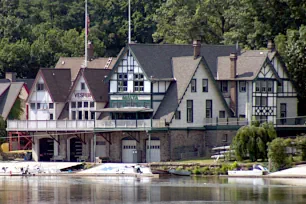Situated on the east bank of the Schuylkill River, Philadelphia’s Boathouse Road is more than just storage for a few racing shells.

About the Houses
Located between Kelly Drive and the Schuylkill River, the Victorian houses of Boathouse Row all have their own unique history. Visible from the city’s Schuylkill Expressway, these houses, which are home to members of the Schuylkill Navy of Philadelphia – the oldest amateur athletic governing body in America, have been on the National Register of Historic Places since 1987.
Fairmount Park’s rowing activity largely centers on these twelve houses. Ten of them belong to rowing clubs, including those of Philadelphia’s Big 5 Universities, which include



Penn (University of Pennsylvania), Temple, St. Joseph’s, Villanova, and La Salle. Another house serves as Fairmount Park’s recreation center, while the last one on the row is a private social club known as The Sedgely Club. In addition, some of the boathouses support local high school rowing teams and provide space for them to store their vessels.
Most of these rowing clubs were organized in the mid-1800s, and their houses were built between the 1870s and 1900. Bachelors Barge Club is the oldest continuously operating rowing club in America, started by a group of unmarried volunteer firefighters who were stationed near the river. Malta Boat Club #9 is almost as old.
Many of the boathouses were designed by well-known architects of the era, such as Crescent Boathouse #5, which was created by renowned architect Charles Balderston. Both the Vesper and the Malta Boathouses were designed by G.H. Hewitt, both houses being semi-attached Victorian Gothic in design. Neighboring Undine Barge Club was designed by Frank Furness, well known throughout the country during the mid-to-late 1800s. Probably the most notable of all the houses, it is known as Castle Ringstetten and is built in typical “Furnesque” style, with beautiful leaded glass and bold forms.
All Lit Up
While its fun to see the houses of Boathouse Row during the day, at night they come alive with thousands of tiny lights, programmable to appear in different colors according to the season. These lights first appeared in 1979 when there was talk of tearing down the houses, some of which were in a good deal of disrepair. The lights brought more attention to these magnificent houses, and most of them have now been refurbished.

